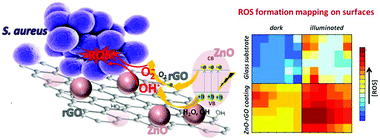Biocide mechanism of highly efficient and stable antimicrobial surfaces based on zinc oxide–reduced graphene oxide photocatalytic coatings†
Abstract
Highly efficient photoactive antimicrobial coatings were obtained using zinc oxide–reduced graphene oxide nanocomposites (ZnO–rGO). Their remarkable antibacterial activity and high stability demonstrated their potential use for photoactive biocide surfaces. The ZnO–rGO nanocomposites were prepared by the sol–gel technique to create photocatalytic surfaces by spin-coating. The coatings were deeply characterised and several tests were performed to assess the antibacterial mechanisms. rGO was homogeneously distributed as thin sheets decorated with ZnO nanoparticles. The surface roughness and the hydrophobicity increased with the incorporation of graphene. The ZnO–rGO coatings exhibited high activity against the Gram-positive bacterium Staphylococcus aureus. The 1 wt% rGO coated surfaces showed the highest antibacterial effect in only a few minutes of illumination with up to 5-log reduction in colony forming units, which remained essentially free of bacterial colonization and biofilm formation. We demonstrated that these coatings impaired the bacterial cells due to cell membrane damage and intracellular oxidative stress produced by the photogenerated reactive-oxygen species (ROS). The enhancement of the ZnO photocatalytic performance upon rGO incorporation is due to the increased detected generation of hydroxyl radicals, attributed to the reduction of electron–hole pair recombination. This intimate contact between both components also conveyed stability against zinc leaching and improved the coating adhesion.



 Please wait while we load your content...
Please wait while we load your content...